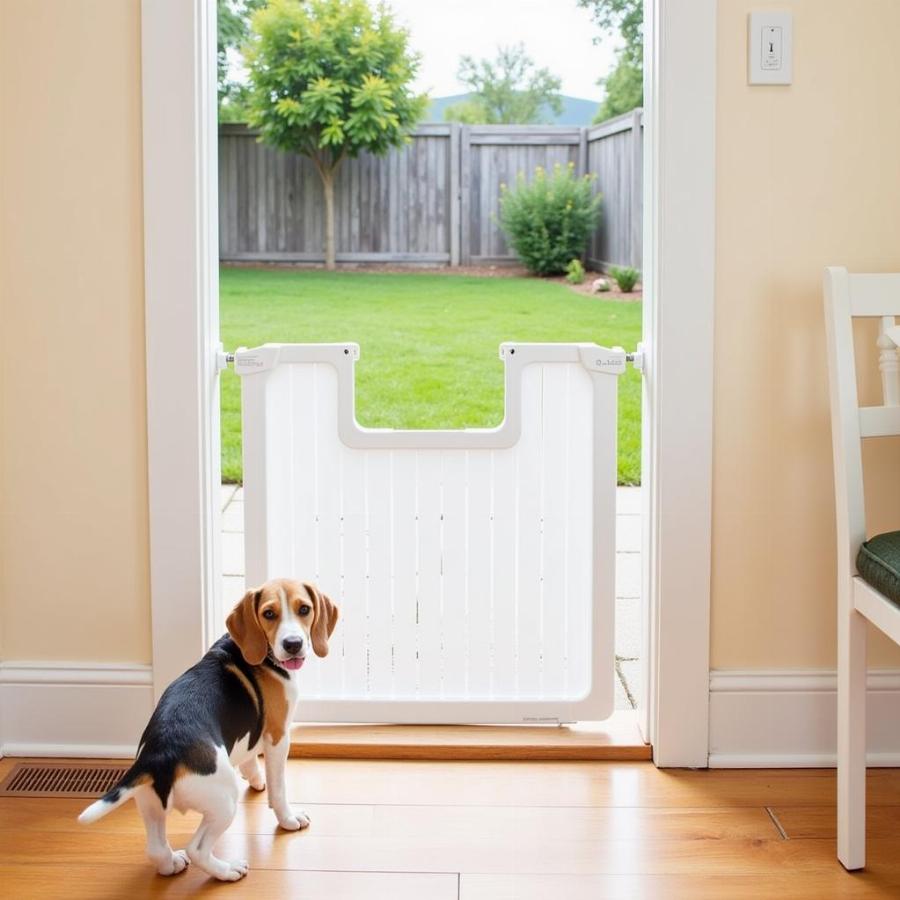A dog gate for outside can be a lifesaver for both you and your beloved pet. Whether you’re looking to create a safe haven on your porch, define boundaries in your yard, or simply provide some controlled outdoor time, a dog gate offers a practical and humane solution. But with so many options available, finding the right one can feel overwhelming. This comprehensive guide explores the world of outdoor dog gates, providing you with the knowledge and insights to make an informed decision that perfectly suits your furry friend’s needs and your lifestyle.
Factors to Consider When Choosing a Dog Gate for Outside
Before diving into the specifics of different dog gate types, it’s important to assess your individual needs and your dog’s characteristics. Consider the following factors:
- Size and Breed: A Great Dane needs a much taller and sturdier gate than a Chihuahua. Always measure your dog’s height at the shoulder and choose a gate that’s appropriately sized.
- Temperament: Is your dog a seasoned escape artist or a mellow homebody? Highly determined pups might require more secure and durable gate options.
- Purpose: What’s the primary reason for using an outdoor gate? Do you need to enclose a specific area or simply create a visual boundary?
- Location: Will the gate be placed on a deck, patio, or directly in the yard? The material and design should complement the environment and withstand the elements.
Types of Outdoor Dog Gates
Understanding the pros and cons of each type will help you make a well-informed decision.
1. Freestanding Dog Gates
As the name suggests, freestanding gates stand on their own without requiring any permanent attachment. They are ideal for temporary use or when you want the flexibility to move the gate around.
- Pros: Portable, easy to set up and move, suitable for renters, available in various materials and designs.
- Cons: Less secure than fixed options, can be knocked over by larger dogs, might not be suitable for uneven terrain.
2. Pressure-Mounted Dog Gates
 Pressure Mounted Dog Gate
Pressure Mounted Dog Gate
These gates utilize pressure to stay in place, wedged between walls or door frames. They are relatively easy to install and remove without damaging surfaces.
- Pros: No tools required for installation, renter-friendly, affordable, suitable for standard doorways and openings.
- Cons: Not as secure as hardware-mounted gates, not ideal for large or strong dogs, pressure can damage walls if not installed correctly.
3. Hardware-Mounted Dog Gates
Offering the highest level of security, these gates are permanently mounted to walls or door frames using screws or bolts.
- Pros: Most secure option, withstands force from larger dogs, provides a permanent solution for containing your pet.
- Cons: Requires drilling and mounting hardware, not renter-friendly, can be more time-consuming to install.
Ensuring Your Dog’s Safety and Comfort
- Choose the Right Size: A gate that’s too short can be easily jumped over, while a gate that’s too tall might not be suitable for your home’s layout.
- Check for Hazards: Before letting your dog loose, inspect the gate and surrounding area for any potential hazards like sharp edges, loose parts, or gaps in the fence.
- Introduce the Gate Gradually: Let your dog sniff and explore the gate before actually using it. You can also use positive reinforcement with treats and praise to create a positive association with the gate.
- Never Leave Your Dog Unattended: While a dog gate provides a safe space, it’s crucial to remember that it’s not a replacement for supervision.
Conclusion
Selecting the right dog gate for outside provides your furry friend with a secure and comfortable environment to enjoy the outdoors. By considering factors like size, temperament, and the intended purpose of the gate, you can choose an option that meets your pet’s specific needs. Remember to prioritize safety and always supervise your dog when they are outside.
FAQs About Dog Gates for Outside
1. Can I use a baby gate as a dog gate?
It’s not recommended. Baby gates are not designed to withstand the weight and strength of a dog and may not offer adequate safety.
2. What material is best for an outdoor dog gate?
Metal gates are generally more durable and weather-resistant, making them suitable for outdoor use.
3. How do I train my dog to use a gate?
Introduce the gate gradually, using positive reinforcement with treats and praise. Never force your dog through the gate.
4. Are wireless dog fences a good alternative to physical gates?
Wireless fences can be effective for some dogs, but they require training and may not be suitable for all breeds or temperaments.
5. Where can I find reputable dog gate brands and retailers?
You can find a wide selection of dog gates at pet stores, online retailers, and home improvement stores.
Looking for More Expert Advice?
For personalized guidance on choosing the perfect dog gate for your furry companion, contact the experts at Beaut Dogs** today! We’re here to help you create a safe and happy environment for your beloved pet. Email us at [email protected] for detailed and accurate answers to all your dog-related questions.
Beaut Dogs is your one-stop resource for all things dog-related, providing trustworthy, helpful, and in-depth information about the canine world. Visit us at https://beautdogs.com to explore our extensive library of articles on dog breeds, care, training, and much more.